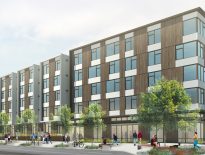Crossing the Chasm Together: Innovation and Advocacy for a New Era
How do you think about your work each day, and the work you are doing as part of this movement? As I consider the purpose of ILFI, I am conscious of a need for and a blossoming of innovation and advocacy. For many of us, I see that innovation comes more naturally and is a part of our work, but advocacy is just as necessary. We are creating a new era for the building industry. As we shift our industry, we are also inspiring other industries in our economy to shift toward regenerative and equitable practices that bring our economy into balance with our planet and each other.
If that sounds lofty, consider this. There are Living Buildings in every climate zone of the USA. We are working with the largest companies in the world, because they see the climate threats, the health threats, and the threats from income inequality. They are making ambitious climate commitments. This is market transformation. And yet amid the curves of market transformation, there is a chasm, as Geoffrey Moore described it in Crossing the Chasm. The goal was never to create a niche industry. We are all connected to something much bigger: transforming how everyone builds and rebuilds, until every building on this planet benefits from regenerative design. As we cross the chasm, we ask: What kind of innovation and advocacy will advance us to this goal?
We are here to show that it is possible to build regenerative buildings and use them as proof to leverage change at scale.
ILFI Theory of Change
Through the Living Building Challenge, teams face legal or regulatory barriers and , a lack of products and materials, among other challenges. We ask that you write letters and state your desire for rule changes, products, and other things that could help realize these projects. You are doing that not for your projects, but for the future, and for your community. And Open House Day is part of the Living Building Challenge because we know that buildings can be beacons and catalysts for community change. This is the ILFI theory of change: We are here to show that it is possible to build regenerative buildings and use them as proof to leverage change at scale. We are here to use our buildings, our products, and our companies as examples to push for system changes.
We are not nearly as far along as we need to be in this transformation. We see dramatic disparities between who has access to safe and healthy buildings and who does not. Our use of toxic chemicals is still on the rise. And despite progress, our global industry’s carbon emissions are going up.
As I look back on the arc of our movement over the past 20 years, I see a resemblance to trickle-down economics. We hoped that after some learned to create these buildings, it would speak to more firms and contractors and homeowners until all of our buildings were transformed. But there are problems with that thinking: One person, firm, and building at a time is way too slow. It also relies on the idea that we can all make choices. Those with resources and connections can, but for many, those choices are not theirs to make at all. And in the case of existing buildings, which we know to be crucial, the choices are even more sparse.
For these reasons, we need policy change. We need building performance laws like Local Law 97 in New York and embodied carbon policies like California’s AB2446. We need to be banning PFAS. We need incentives and structures to hasten the creation of regenerative buildings and communities. At ILFI, we are building relationships to help envision what these might be. We proved that these buildings were possible, and now we need policies to ensure that all projects can be built and rebuilt this way.
I’m excited about a new coalition we are forming with other non-profits in our space—including Architecture 2030, Building Transparency, Carbon Leadership Forum, and USGBC—to align our industry around whole-building embodied carbon accounting, so that we can accelerate that part of the market transformation. There is a tremendous amount of work under way: we are gathering more proof points, developing the Living Building Challenge Version 5.0, and creating a toolkit to help people use those projects as beacons. We look forward to sharing that work and we hope that you will join the effort, through our new Technical Advisory Groups and other engagement opportunities.
Our theory of change is bold. It reaches far beyond the built environment community. We create buildings, products, and practices and invite people to join us on this positive path. We know these places and processes can change people. We need every lawmaker, teacher, business leader, and community member to walk these buildings with us to see what it feels like to live in a better world. The chasm leap and the broad invitation require us to know our power and act like a movement. We have incredible opportunity and responsibility. It is inspiring work. It is beautiful work.


